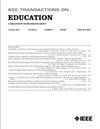在工程数学中使用评分标准的设计原则
IF 2.1
2区 工程技术
Q2 EDUCATION, SCIENTIFIC DISCIPLINES
引用次数: 0
摘要
贡献:这篇概念性文章展示了数学能力研究框架(MCRF)如何指导工程数学任务评估标准的设计。文章为工程数学教育工作者提供了实用指导,帮助他们创建有效的评分标准,支持学生学习,促进学业成功。背景:作者认为,包含一些评分标准评估的任务可以帮助学生更好地应对具有数学挑战性的概念。通过明确所需的数学能力,学生可以在数学课外更好地利用数学概念。研究问题:使用评分标准培养学生数学能力的设计原则是什么?研究方法:将有关评分标准设计的文献与 MCRF 和工科毕业生的特质相结合,为涉及数学能力的任务设计评分标准的原则。研究结果:介绍了与六种数学能力相一致的通用评分标准,并以在 GeoGebra 上分析具有复杂阻抗的交流电路的任务和评分标准为例。通过让学生表达他们的价值,评分标准的设计有助于应对包容性的挑战。本文章由计算机程序翻译,如有差异,请以英文原文为准。
Design Principles for Using Rubrics in Engineering Mathematics
Contribution: This concept article shows how the mathematical competencies research framework (MCRF) can guide the design of rubrics to assess engineering mathematics tasks. Practical guidance is given for engineering mathematics educators wanting to create effective rubrics that support student learning and promote academic success. Background: The authors argue that including some rubric-assessed tasks can help students cope better with mathematically challenging concepts. By making explicit the mathematical competencies needed, students may make better use of mathematics concepts outside of mathematics classes. Research Question: What are the design principles for using rubrics to develop mathematical competencies in a way that enables engineering students to voice their values? Methodology: Literature on rubric design was combined with the MCRF and engineering graduate attributes to design rubric principles for tasks involving mathematics competencies. Findings: A general rubric is presented, aligned to six mathematical competencies, with an example of a task and rubric for analyzing ac circuits with complex impedance on GeoGebra. By giving room for students to voice what they value, the rubric design helps to address the challenge of inclusion.
求助全文
通过发布文献求助,成功后即可免费获取论文全文。
去求助
来源期刊

IEEE Transactions on Education
工程技术-工程:电子与电气
CiteScore
5.80
自引率
7.70%
发文量
90
审稿时长
1 months
期刊介绍:
The IEEE Transactions on Education (ToE) publishes significant and original scholarly contributions to education in electrical and electronics engineering, computer engineering, computer science, and other fields within the scope of interest of IEEE. Contributions must address discovery, integration, and/or application of knowledge in education in these fields. Articles must support contributions and assertions with compelling evidence and provide explicit, transparent descriptions of the processes through which the evidence is collected, analyzed, and interpreted. While characteristics of compelling evidence cannot be described to address every conceivable situation, generally assessment of the work being reported must go beyond student self-report and attitudinal data.
 求助内容:
求助内容: 应助结果提醒方式:
应助结果提醒方式:


